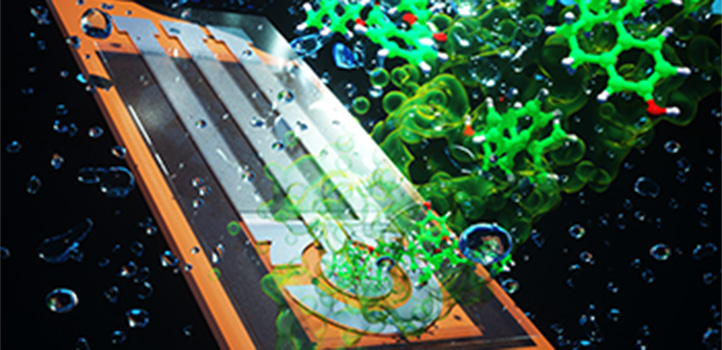Nov 17 2020
Researchers at KAUST have devised a simple technique that involves using laser beams to develop graphene electrodes with better performance compared to those made using previous techniques.
 The LDG/MIP-based electrochemical sensor sensitively and selectively detects BPA in water samples. Image Credit: © 2020 KAUST.
The LDG/MIP-based electrochemical sensor sensitively and selectively detects BPA in water samples. Image Credit: © 2020 KAUST.
Electrodes made of graphene, an atypical form of carbon, may revolutionize the detection and measurement of electroactive substances in various fields, spanning from clinical diagnosis and food safety to environmental monitoring.
Graphene includes several highly ordered and ultrathin sheets of interconnected honeycomb-shaped rings of carbon atoms. This multilayered architecture offers the material excellent electronic properties, specifically electrocatalytic activity and electrical conductivity, besides physical features that are valuable for making electrochemical sensors.
Graphene electrodes are essentially created by peeling off individual sheets from graphite or through the deposition of a reactive gaseous mixture of precursors onto a substrate. But these techniques involve time-intensive, multistep production and isolation processes; moreover, achieving control over the oxidation and stacking of the sheets is hard in these techniques.
To optimize technically difficult and costly methods, scientists at Khaled Salama’s lab, together with their colleagues, devised a simple, scalable technique to use a laser beam to convert carbon or polymer precursor films into graphene electrodes.
This mask-free method can be used to synthesize uniform, three-dimensional multilayered electrodes that offer a combination of high porosity and surface area, essential for next-generation electrochemical sensor and biosensor platforms.
Salama’s team and their colleagues from the Hassan II University of Casablanca, Morocco, combined laser-derived graphene (LDG) electrodes in sensing platforms for key sources of antioxidants known as phenolic compounds and associated electroactive biomolecules.
All analyzed compounds exhibited higher electrocatalytic activity on the graphene-based platforms compared to what they exhibited on traditional systems that use carbon electrodes.
The graphene-based platforms showed excellent performance for detecting paracetamol, a common drug.
Abdellatif Ait Lahcen, Postdoc, Khaled Salama’s Lab, KAUST
They also differentiated paracetamol in a commercially available tablet that blends the drug with the antioxidant ascorbic acid, which usually leads to interferences in standard electrochemical analyses.
A study of the electrochemical behavior of a set of hormones and neurotransmitters known as catecholamines also offered insights into the mechanisms of oxidation-reduction reactions of these compounds.
Sensor performance can be optimized through various electrode modification methods. Although biological receptors—for example, antibodies, enzymes, and nucleic acids—offer target-specific sensors, they need complex surface immobilization techniques.
Promising alternatives are emerging for such natural receptors. Synthetic polymers called molecularly imprinted polymers (MIPs) are easy to produce and durable.
Researchers at KAUST intend to improve the fabrication of sensors and widen their applications to other disease biomarkers and biomolecules.
We are developing MIP-modified biomimetic sensors for the early detection of breast cancer biomarkers.
Abdellatif Ait Lahcen, Postdoc, Khaled Salama’s Lab, KAUST
LDG electrodes were modified by the researchers by using MIPs to create an inexpensive sensor to detect bisphenol A (BPA) in samples of water and plastic.
As part of the modification, the researchers produced polypyrrole under applied voltage in the presence of BPA molecules, which served as templates and formed imprints in the polymer when removed. The sensor exhibited higher selectivity and sensitivity toward BPA compared to other similar substances like bisphenol F, estradiol, and epinephrine.
Combining LDG electrodes with MIPs will lead to new highly sensitive and selective electrochemical sensors.
Tutku Beduk, PhD Student, Khaled Salama’s Lab, KAUST
According to Salama, these MIP-based sensors will be useful to ensure water stays pure, clean, and toxin-free.
Journal Reference:
Lahcen, A. A., et al. (2020) Electrochemical sensors and biosensors using laser-derived graphene: A comprehensive review. Biosensors and Bioelectronics. doi.org/10.1016/j.bios.2020.112565.